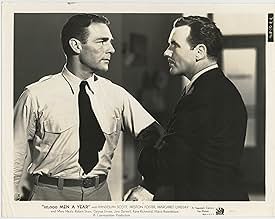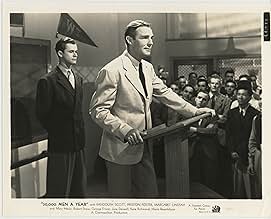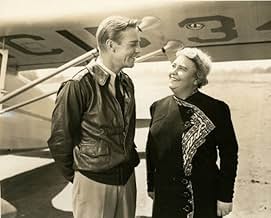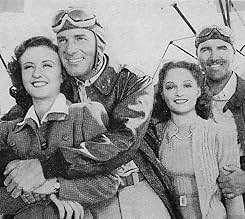Pilot disobeys unsafe orders and loses his job. He then starts a flying school which receives a boost when the government launches a program which it hopes will produce 20,000 pilots a year.Pilot disobeys unsafe orders and loses his job. He then starts a flying school which receives a boost when the government launches a program which it hopes will produce 20,000 pilots a year.Pilot disobeys unsafe orders and loses his job. He then starts a flying school which receives a boost when the government launches a program which it hopes will produce 20,000 pilots a year.
- Director
- Writers
- Stars
Maxie Rosenbloom
- Walt Dorgan
- (as Max 'Slapsie Maxie' Rosenbloom)
George Chandler
- Soda Jerker
- (uncredited)
Harrison Greene
- Mr. Jones
- (uncredited)
- Director
- Writers
- All cast & crew
- Production, box office & more at IMDbPro
Featured reviews
Although I have never seen this movie I can confirm that the flying sequences were shot at Monrovia Airport near Pasadena. This airport closed in 1953, according to the website "Abandonned and little known airports", which details many airports in California and elsewhere which were used as movie locations. Interestingly very close to the airport was the site of the very first Macdonalds restaurant. There is now no sign whatsoever that there ever was an airport there, like many old airports in the LA area the unstoppable tide of housing and commercial development has erased all memory. Laurel and Hardy also filmed at the airport on occasion, and I have seen amateur colour footage of a Boeing 247 being used during the filming of a scene at Monrovia from an unknown "gangster" movie.
20,000 Men A Year refers to the number of new pilots expected to be turned out annually with a new program that the Civil Aeronautics Agency has authorized certain schools. This film was one of the first of the preparedness films that the studios were starting to turn out though no name of a potential enemy is specified.
To give the film a ring of real aeronautical authenticity it was written by the legendary Frank 'Spig' Wead who certainly captures the love of aviation among the veterans and the eager young kids learning the ropes.
There are three components in the plot of 20,000 Men A Year. The first is the rivalry between by the CAA administrator Preston Foster and veteran flier Randolph Scott. Foster grounds Scott after disobeying orders, in fact I thought Scott used good judgment. The second component is the rivalry, but possible romance developing between Scott and Margaret Lindsay as Scott tries to persuade her to let younger brother George Earnest learn to fly and join the school program he has now become the head of.
Lastly though is a hair raising rescue of some of the principal players in the Grand Canyon. Some really nice aerial sequences are done here. All the elements mix nice to form a nice and entertaining film.
The film seems to have been done a disservice in the editing department. Still 20,000 Men A Year deserves to be better known than it is.
To give the film a ring of real aeronautical authenticity it was written by the legendary Frank 'Spig' Wead who certainly captures the love of aviation among the veterans and the eager young kids learning the ropes.
There are three components in the plot of 20,000 Men A Year. The first is the rivalry between by the CAA administrator Preston Foster and veteran flier Randolph Scott. Foster grounds Scott after disobeying orders, in fact I thought Scott used good judgment. The second component is the rivalry, but possible romance developing between Scott and Margaret Lindsay as Scott tries to persuade her to let younger brother George Earnest learn to fly and join the school program he has now become the head of.
Lastly though is a hair raising rescue of some of the principal players in the Grand Canyon. Some really nice aerial sequences are done here. All the elements mix nice to form a nice and entertaining film.
The film seems to have been done a disservice in the editing department. Still 20,000 Men A Year deserves to be better known than it is.
Student training program--wwii\\
When the story begins, Brad (Randolph Scott) gets in trouble with the airline he works for and he loses his job. He soon starts up a flying school but it's a flop...and he's on the verge of bankruptcy. But when the CAA (the precursor of the FAA today) wants to dramatically increase the number of pilots, he's in luck...as they need 20,000 new pilots a year. The rest of the story is about this training program...with its up and downs...including Brad working with the brother of his nemesis in the school.
So why did the CAA want to dramatically increase the number of pilots in 1939? Well, many in the US thought that the country would eventually be pulled into WWII....and having able-bodied trained pilots would be necessary. On the surface this and many other programs were described in non-military language, as many in the US favored neutrality....but clearly it was designed with producing pilots who could fly for the Army Air Corps was the goal here.
So is the story any good? Well, it's the epitome of mediocrity. There's nothing particularly good nor bad about the film. In fact, apart from a few nice flying sequences and Randolph Scott (who's always quite good), it has nothing to make it stand out in any way. A time-passer...not much more....even with its WWII connection.
When the story begins, Brad (Randolph Scott) gets in trouble with the airline he works for and he loses his job. He soon starts up a flying school but it's a flop...and he's on the verge of bankruptcy. But when the CAA (the precursor of the FAA today) wants to dramatically increase the number of pilots, he's in luck...as they need 20,000 new pilots a year. The rest of the story is about this training program...with its up and downs...including Brad working with the brother of his nemesis in the school.
So why did the CAA want to dramatically increase the number of pilots in 1939? Well, many in the US thought that the country would eventually be pulled into WWII....and having able-bodied trained pilots would be necessary. On the surface this and many other programs were described in non-military language, as many in the US favored neutrality....but clearly it was designed with producing pilots who could fly for the Army Air Corps was the goal here.
So is the story any good? Well, it's the epitome of mediocrity. There's nothing particularly good nor bad about the film. In fact, apart from a few nice flying sequences and Randolph Scott (who's always quite good), it has nothing to make it stand out in any way. A time-passer...not much more....even with its WWII connection.
Randolph Scott is a fine but cocksure commercial pilot who gets suspended for putting his judgment over the traffic controller's. He tears up his contract and tries to make a go running an airfield and training pilots. He's bankrupt, and the airlines aren't hiring anyone over 30. But the Government passes subsidies for pilot training, and he winds up in charge of a pilot course at a college. There, he runs into a variety of students. One of them is the brother of Preston Foster, the airline inspector who grounded him. He also begins a rocky courtship with Margaret Lindsay, a sociology professor who doesn't want her brother flying.
With a script co-written by Frank Wead, there's plenty of good sense and excitement, including a spectacular landing with a plane whose landing gear is broken. Alfred Green directs well, as expected, and the aerial footage is spectacular.
Given the international situation, opening titles talk about how the future in flying is commercial. Pilots weren't gonna study war no more. That would change in a couple of years.
It's a Cosmopolitan co-production with 20th Century-Fox. Hearst's media empire had declined from its glory days in the 1920s; a lot of assets were being sold off, and the film unit would end this year.
With a script co-written by Frank Wead, there's plenty of good sense and excitement, including a spectacular landing with a plane whose landing gear is broken. Alfred Green directs well, as expected, and the aerial footage is spectacular.
Given the international situation, opening titles talk about how the future in flying is commercial. Pilots weren't gonna study war no more. That would change in a couple of years.
It's a Cosmopolitan co-production with 20th Century-Fox. Hearst's media empire had declined from its glory days in the 1920s; a lot of assets were being sold off, and the film unit would end this year.
Did you know
- TriviaNew York City premiere October 27 1939 at the Roxy Theatre.
Details
- Release date
- Country of origin
- Language
- Also known as
- 20.000 Kahraman
- Filming locations
- Production companies
- See more company credits at IMDbPro
- Runtime1 hour 24 minutes
- Color
- Aspect ratio
- 1.37 : 1
Contribute to this page
Suggest an edit or add missing content





































